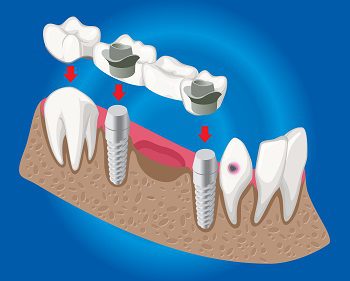What Are Dental Crowns and Bridges?
If you are missing a tooth, it’s imperative to fill the gap. Otherwise, the surrounding teeth will shift and will cause further dental problems. Besid...

If you are missing a tooth, it’s imperative to fill the gap. Otherwise, the surrounding teeth will shift and will cause further dental problems. Besides causing dental issues, your facial shape will change, impacting your smile. According to estimates, around 178 million Americans are missing at least one tooth. Tooth loss is widespread, where 69% of the global population has at least one missing tooth by the age they reach 35. Dental crowns and bridges provide convenient ways to fix your missing teeth.
Today, there are many dental methods to improve the smile and aid in the chewing process. However, dental crowns and bridges have remained the safe and preferred choices for decades. You might wonder which one to consider for your missing tooth replacement. Here, we’ll discuss the details of crowns and bridges, along with their differences, for your general understanding.
“Dental bridges and crowns have an average success rate of over 95%. They both can last for several decades with the right dental care”.
What Is a Dental Crown and Why It’s Needed?
A dental crown is placed on the top of a damaged tooth like a tooth-shaped cap. The purpose of a crown is to restore the tooth’s function, strength, size, shape, and appearance. It helps protect the tooth against bacteria and other harmful irritants in the mouth. Since the crown fully encases the tooth; so, the food particles, saliva, bacteria, and acids cannot reach it. These irritants usually cause most dental problems in the mouth.
There are numerous types of crowns available today. Your dentist recommends the right type that matches your dental health and affordability range. Sometimes, it’s up to the patient’s willingness to the kind of crown they want to wear. Some of the types of crowns are:
- Stainless Steel Crown: It is mainly employed when the patient has to wear a temporary crown. A temporary crown is fitted primarily in the mouth before a permanent one arrives. A stainless-steel crown protects the tooth against bacteria until the permanent crown is placed.
- Metal Crown: The metal or titanium crown is durable and incredibly strong. A metal crown has great resistance against decay and easily withstands biting and chewing forces. It’s a durable option and more expensive than other types.
- Porcelain Crown: Porcelain is the best material that mimics the natural tooth. It is well-suited for patients needing a crown in a front damaged tooth. It is quite popular in restorative and cosmetic dentistry, providing a natural look.
- Hybrid Crown: The hybrid crown blends metal (titanium) and porcelain. It is a durable crown that mimics the natural tooth. It is ideal for people who want to consider durability along with aesthetics.
Sometimes, getting a dental filling is all you need to restore the tooth’s function. Generally, a dental filling is used to repair a small portion of the damaged tooth. In contrast, a dental crown protects the tooth entirely when a dental filling can’t repair it. A dental crown is most suited in the following situations:
- Failed dental filling: Sometimes, a dental filling comes loose because of recurring decay. The filling breaks, so you need a dental crown to protect your tooth’s structure.
- Multiple or Large Cavities: Large cavities compromise the tooth’s structure. That’s why many dentists use crowns to enable the tooth’s function. Preparing for a tooth filling might fail.
- After Root Canal Procedure: A root canal procedure is usually suggested when you have severely decayed teeth. After the infected pulp is removed, it is sealed afterward. The sealant is mainly covered with a crown to provide strength and durability to the tooth.
- Fractured Tooth: A fractured tooth refers to a broken, chipped, or cracked tooth. It usually results due to an injury, trauma, or accident. The fillings may fix minor cracks; however, a dental crown is a better option for providing added protection.
- Discolored or Weak Enamel: Sometimes, the tooth’s enamel is weakened or discolored. A tooth with weak enamel is more prone to cavities and decay. Crown placement keeps such a tooth healthy.
- Multiple Fillings: A crown is better if you have multiple amalgam fillings in the mouth. More than eight amalgam fillings increase mercury in the blood and cause serious health issues, such as neurological disorders.
What Is a Dental Bridge and What Are Its Functions?
A tooth bridge is a false tooth that permanently replaces a missing tooth. With one or more missing teeth, a dental bridge can help fill the gap. A dental bridge can last up to several decades with the right care. Replacing a missing tooth is essential to fill the gap. Your teeth work together and having one or more missing teeth cause problems. If a tooth is missing, the surrounding teeth move into the space to cause problems. These include chewing difficulties, bite issues, and pain from extra stress on the jaw and teeth.

A dental bridge fixes such problems and aids in chewing and speaking ability. Besides providing better aesthetics, it also restores your smile and dental health. A typical dental bridge comprises abutment teeth and a false tooth (pontics). The anchoring or abutment teeth in a dental bridge could be your natural teeth or dental implants. The four main types of dental bridges include the following.
- Traditional Bridge: Traditional bridge is the most common type; it has two or more crowns and a false tooth. It is usually made of ceramics, porcelain, or metal.
- Cantilever Bridge: The cantilever bridge connects the false tooth to only one abutment tooth. It suits people with teeth on only one side of the gap.
- Resin-bonded Bridge: The resin-bonded bridge is also known as Maryland dental bridge. This type is mainly employed when patients have missing teeth at the front.
- Implant-Supported Bridge: This bridge is similar to the traditional type except that it is held in place by the implants.
Today, dental bridge is available in different types, and your oral health professional is the right person to suggest to you. Sometimes, dental implants are unsuitable for patients with one or more missing teeth. It could be due to affordability, bone defect, or your busy work schedule. Here we will discuss when you need a tooth bridge compared to dental implants.
- You Want a Fast Treatment. Sometimes, a person is a qualifying candidate for dental implants. A dental bridge is suitable if you want a fast treatment to replace missing teeth. But, its procedure could be more time-consuming. It usually takes about six months to place the implants. In contrast, bridges take about three weeks (maximum) to replace the missing teeth.
- There Is an Underlying Bone Defect. The success rate of a dental implant heavily depends upon bone density. If there is an underlying bone defect, you will require another procedure known as a “bone graft.” On the other hand, a dental bridge can even be fitted with a bone defect and replaces the missing teeth.
- You Have Budget Issues. Dental implants are quite costly, and not everyone can afford these. A dental bridge is a cost-effective way to replace your missing tooth.
- Your Teeth Are Missing for So Long. When the teeth are missing for so long, the dentist has to employ braces to fit the implants. Also, the surrounding teeth have tilted in the open space because of the gap. A dental bridge reshapes those tilted teeth and replaces the missing ones.
- You Have 3-4 Missing Teeth in a Row. A dental bridge is most suited to patients who have 3-4 missing teeth in a row. It restores the chewing and speaking capability within a short time.
Similarities and Differences Between a Dental Crown Bridge
Dental crowns and bridges have many similarities in function and aesthetics. Both of these aid in the chewing process and make it easier to talk. They provide a hassle-free way to take care of them and are super easy to maintain. Placing a crown or dental bridge helps restore your smile and makes you feel more confident. They usually last more than a decade with the proper oral hygiene routine.
Besides many similarities, there are some differences as well. First, a crown is used to protect the damaged tooth. The crown acts like a covering to provide strength and durability to the tooth. A dental bridge helps fill the gap created due to one or more missing teeth. It comprises two crowns with a false tooth in the middle to fill the void. Second, your dentist can fit a crown on the same day if his office provides this facility. Otherwise, you may require at least two dental visits for crown placement. In contrast, a dental bridge usually takes three weeks to complete.
Conclusion
Dental crowns and bridges provide a cost-effective way to restore decayed or missing teeth. A crown is best if the tooth is still functional but decayed. However, a dental bridge is the best choice if a tooth is beyond repair or needs to be extracted. If you have missing or decayed teeth, visit your dentist soon for optimal oral health.
Contact your Walnut Creek Dentist, Dr. Tiziana Procopio Towle, DDS, at Procopio Towle Dental Office to learn more about dental crowns and bridges.
Resource:
What are the different types of Dental Bridges?
*This media/content or any other on this website does not prescribe, recommend, or prevent any treatment or procedure. Therefore, we highly recommend that you get the advice of a qualified dentist or other medical practitioners regarding your specific dental condition*
Get to know us
The best and gentle Dentists and Team Member of Procopio Towle Dental Office are dedicated to providing top quality dental care to patients in Walnut Creek the surrounding San Francisco Bay Area.
Meet Our Dentist



